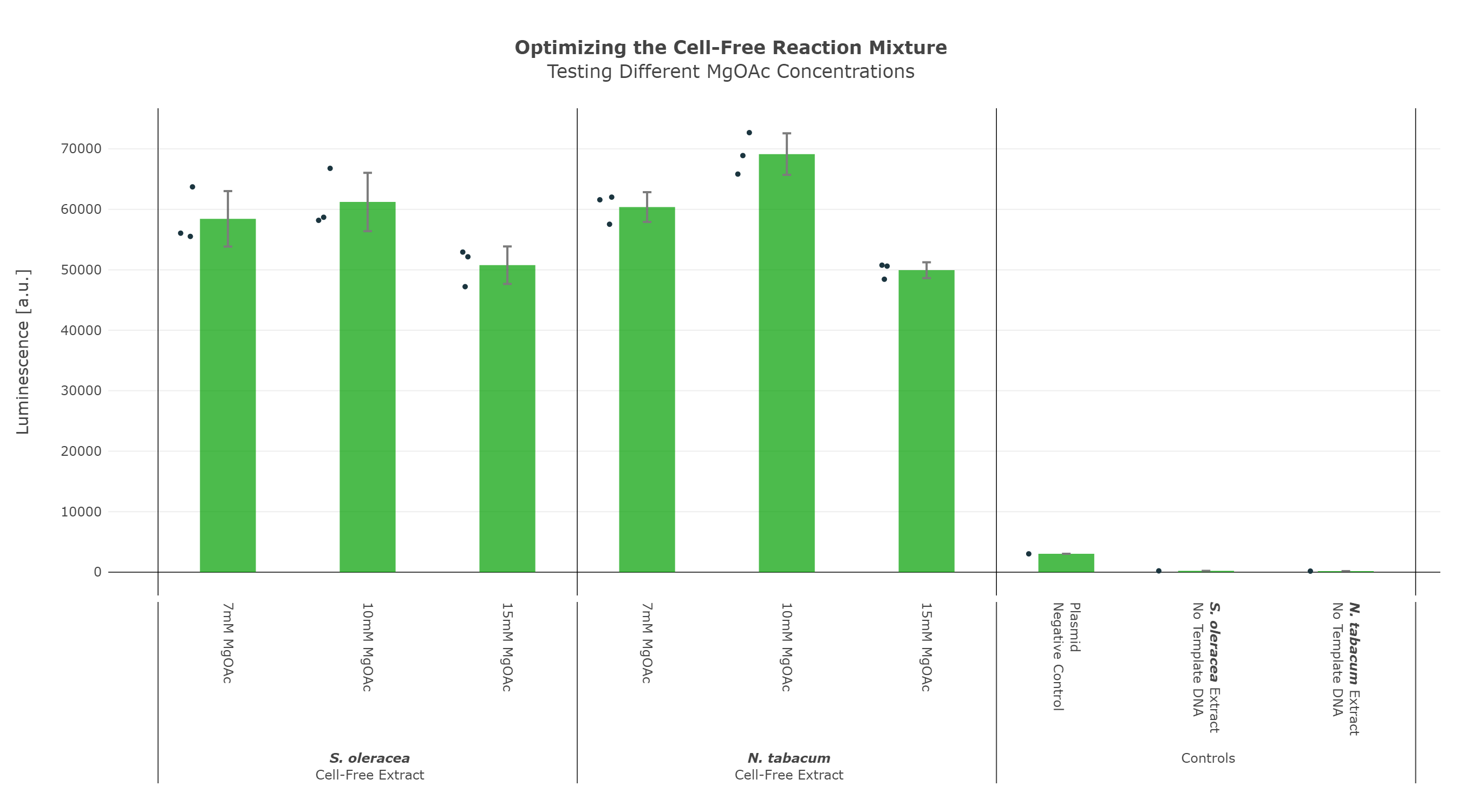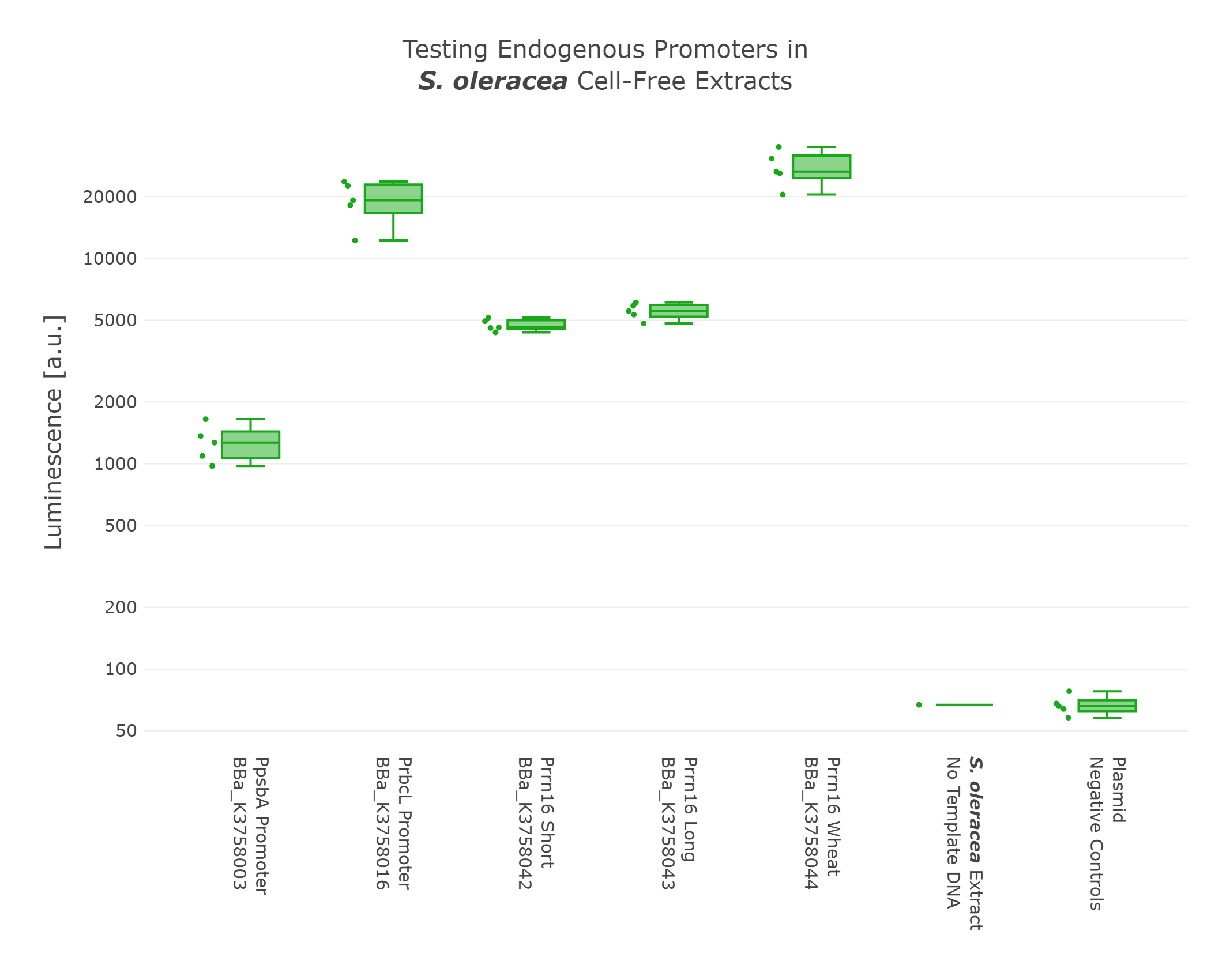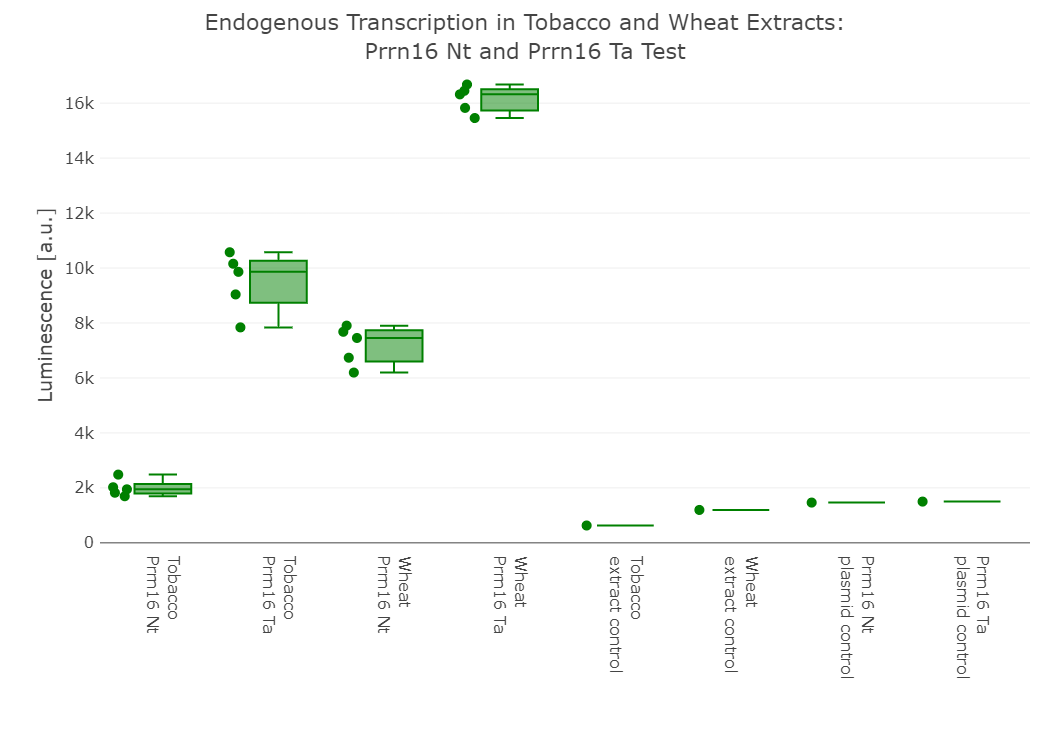Difference between revisions of "Part:BBa K3758042"
MichaelCWB (Talk | contribs) |
MichaelCWB (Talk | contribs) |
||
| Line 112: | Line 112: | ||
</figure></center></html> | </figure></center></html> | ||
<p> | <p> | ||
| − | For this experiment, we wanted to have a direct comparison between the 16S promoter from Tobacco and Wheat in their respective chloroplast cell-free extract. The results show that the 16S promoter from Wheat performs better in each extract and might therefore be better suited for higher gene expression. We are aware that this expression is not quantitative, as we were missing a proper normalization method. But, as the expression using the Wheat promoter showed higher expression in the extracts intrinsically, there might be an underlying mechanism that causes higher expression, which we might not yet fully understand. | + | For this experiment, we wanted to have a direct comparison between the 16S promoter from Tobacco and Wheat in their respective chloroplast cell-free extract. The results show that the 16S promoter from Wheat performs better in each extract and might therefore be better suited for higher gene expression. We are aware that this expression is not quantitative, as we were missing a proper normalization method. But, as the expression using the Wheat promoter showed higher expression in the extracts intrinsically, there might be an underlying mechanism that causes higher expression, which we might not yet fully understand.</p> |
<html> | <html> | ||
Latest revision as of 11:33, 10 August 2023
Prrn16, rrn16 promoter (short version) Nicotiana tabacum
Contents
Part Description
This part was created using the Phytobrick Entry Vector with GFP dropout BBa_K2560002 and was designed to be compatible with the Phytobrick assembly standard. This years BioBricks were either constructed via PCR from purified DNA samples using a CTAB based method [1], by primer annealing, primer annealing, and extension reactions or synthesized via IDT/Twist.
All parts this year were produced to be used in the chloroplast of different plant species. For the characterization of these parts they were tested in chloroplast cell-free systems (ccfs) from either the same species or they were tested in ccfs from other plant species. Plastid parts offer the benefit of highly conserved regulatory sequences that can be used across species. Although characterizing chloroplast parts is a huge effort, in literature, it has been shown that plastid parts can be used across species to drive gene expression [2]. We believe that based on this knowledge we can create valuable parts that can be screened for activity in our system with the final goal of building a variety of different parts. This collection shall help combat unwanted recombination events in vivo that sometimes impede the successful functionality of the genetic design.
Best Basic Part
We proudly present our best new basic part: the rrn16 promoter from tobacco.
We have extensively characterized this part by showing its functionality in three different species and also demonstrated that it can be easily transferred to other plant chassis. Furthermore, we have established this part as reference to allow future teams to optimize the endogenous machinery in their in-vitro systems.
The PEP Promoter
Transcription in the chloroplast is mainly driven by two different RNA Polymerases: plastid-encoded polymerase (PEP) and nuclear-encoded polymerase (NEP).
The PEP is a bacterial-like polymerase that is a remnant of the chloroplast’s cyanobacterial ancestor and is only capable of promoting gene expression in the plastid. These polymerases are able to interact with nuclear-encoded sigma factors and therefore are able to recognize bacterial promoter motives such as the -35 (TTGACA) and the Pribnow (TATAAT) box. Similar to bacteria there are different sigma factors promoting gene expression under different growth conditions. As the PEP is structurally more sophisticated there are even more peptides involved in DNA transcription that is not fully understood yet.
The NEP Promoter
The NEP is a T3/T7 phage-like polymerase that is encoded in the nucleus and is imported into the chloroplast. It was proposed that this polymerase is a remnant of a horizontal gene transfer from a bacterium to a eubacterial ancestor of today's plant cells [3] [4]. This type of polymerase mainly promotes gene expression in the early developmental stages of the chloroplast. In mature chloroplasts, it continues to transcribe housekeeping genes like the subunits of the plastid-encoded polymerase (rpoA, rpoB, rpoC1, and rpoC2) and proteins involved in fatty acid biosynthesis such as acetyl-CoA carboxylase (accD). In contrast, the PEP is rather active in mature chloroplasts and is primarily involved in the expression of photosynthetic genes. For other non-photosynthetic genes, motives of both polymerases can be found and it has been shown that both can promote transcription using deletion studies of important promoter sequences [5] [6].
The rrn16 Promoter and its Regulation
Expression of the plastid rRNA operon (rrn) is heavily regulated at the level of transcription during development . In most higher plants the rrn operon is transcribed by the plastid-encoded RNA polymerase (PEP), the multisubunit plastid RNA polymerase from PrrnP1, a σ70-type promoter with conserved −10 and −35 core promoter elements.

The 16S promoter and the PEP polymerase
The RUA motive can be seen directly upstream the -35 region of the rrn promoter promoting high levels of transcription
It has been shown that sequences upstream of nucleotide −83 do not significantly contribute to promoter function. Moreover it has been demonstrated that an essential hexameric sequence upstream of the −35 element (the rRNA operon upstream activator [RUA], GTGGGA; ) that is conserved in monocot and dicot species and that the −10 element plays only a minor role in PrrnP1 recognition. Mutations in the initial transcribed sequence (+9 to +14) enhanced transcription, which is also the characteristic of strong promoters in prokaryotic chassis. It has been proposed that σ interaction with the −10 element in PrrnP1 is replaced in part by direct PEP-RUA (protein–DNA) interaction or by protein–protein interaction between the PEP and an RUA binding transcription factor.
Characterization & Measurement
Batch effect
A major difficulty when working with cell free technology is the reproducibility of reliable data generation. While one batch of cell free extract generation might be perfectly suited for efficient protein production, other batches might not perform that well. Because our chloroplast extracts were prepared from leaves, each preparation could have contained distinct compositions of differentiated leaf cells (for example: mesophyll, palisade parenchyma and bundle sheath) from plants that experienced microclimatic variations. This in turns causes the individual difference in expression strength, making it impossible to quantitatively compare data across measurements.
Dual Luciferase normalization
To tackle the aforementioned issue, we designed our measurement construct to harbor two individual luciferase cassettes. A standardized cassette that includes the Firefly luciferase (FLuc) is included in every measurement construct in order to have a reference point to which we can normalize our gained data to[14] . The second cassette consists of a Nano Luciferase (NLuc) harboring a placeholder part in either the promoter, 5’UTR or 3’UTR position. This enables quick exchange of a series of lvl0 parts allowing for high throughput characterization of genetic parts.
Placeholder
For the characterization of the parts produced this year, we made use of Golden Gate placeholder parts introduced by [http://2019.igem.org/Team:Marburg iGEM Marburg 2019]: BBa_K3228060, BBa_K3228061 and BBa_K3228063. These placeholder parts can be used in assemblies to subsequently replace it with another part of the same type in a secondary Golden Gate assembly. A placeholder can rationalize large-scale assemblies: Instead of building each plasmid from scratch, a placeholder is used to generate an entry vector.
Results

Optimization of the magnesium concentration for endogenous transcription
Luminescence values are given as arbitrary units and the data is presented on a linear scale. The reaction was set up in a total volume of 10µl. Negative controls using only the plasmid DNA or the crude chloroplast extracts have been included respectively in order to verify the expression
This part has been measured alongside BBa_K3758003, BBa_K3758016, BBa_K3758042, BBa_K3758043 and BBa_K3758044. All of these promoters have been tested in chloroplast cell-free extracts of Spinach. The lvl1 construct can be found here: BBa_K3758314

Characterization of endogenous promoter
Luminescence values are given as arbitrary units and the data is presented on a linear scale. The reaction was set up in a total volume of 10µl. Negative controls using only the plasmid DNA or the crude chloroplast extracts have been included respectively in order to verify the expression
For this experiment, we wanted to have a direct comparison between the 16S promoter from Tobacco and Wheat in their respective chloroplast cell-free extract. The results show that the 16S promoter from Wheat performs better in each extract and might therefore be better suited for higher gene expression. We are aware that this expression is not quantitative, as we were missing a proper normalization method. But, as the expression using the Wheat promoter showed higher expression in the extracts intrinsically, there might be an underlying mechanism that causes higher expression, which we might not yet fully understand.

Prrn16 promoter from Tobacco and Wheat measured in cell-free systems of Tobacco and Wheat
Luminescence values are given as arbitrary units and the data is presented on a linear scale. The reaction was set up in a total volume of 10µl. Negative controls using only the plasmid DNA or the crude chloroplast extracts have been included respectively in order to verify the expression
The results give a strong indication that some chloroplast PEP promoters might indeed be functional in other plant chloroplasts as well due to their close relation. It can also be seen that the motifs of the various promoters are extremely close to known promoter motives from E. coli. This was also noticable as these construct already showed high expression, during the cloning steps in E. coli.
Marburg collection 3.0
We proudly present the third expansion of the Marburg collection [15]. The Marburg collection is a Golden Gate based toolbox containing various parts that are compatible with the PhytoBrick system and MoClo. Compared to other bacterial toolboxes, the Marburg Collection shines with superior flexibility. The collection overcame the rigid paradigm of plasmid construction - thinking in fixed backbone and insert categories - by achieving complete de novo assembly of plasmids.
36 connectors facilitate flexible cloning of multigene constructs and even allow for the inversion of individual transcription units.
The original [http://2018.igem.org/Team:Marburg/Part_Collection Marburg Collection] contains 123 parts in total, including:
inducible promoters, reporters, fluorescence and epitope tags, oris, resistance cassettes and genome engineering tools. The toolbox was constructed as a foundation for future iGEM teams to empower accelerated progression in their ambitious projects.
Our collection includes genetic parts suitable for use in the chloroplast. Among parts from the chloroplast of Nicotiana tabacum, we built parts from the chloroplast of Spinacia oleracea, Oryza sativa,Triticum aestivum and Quercus robur. With our contribution, we aim to accelerate research in the field of plastid engineering.
Sequence and Features
- 10COMPATIBLE WITH RFC[10]
- 12COMPATIBLE WITH RFC[12]
- 21COMPATIBLE WITH RFC[21]
- 23COMPATIBLE WITH RFC[23]
- 25COMPATIBLE WITH RFC[25]
- 1000COMPATIBLE WITH RFC[1000]
References
[1] Aboul-Maaty, N. A.-F., & Oraby, H. A.-S. (2019). Extraction of high-quality genomic DNA from different plant orders applying a modified CTAB-based method. Bulletin of the National Research Centre, 43(1). https://doi.org/10.1186/s42269-019-0066-1
[2] Fuentes, P., Zhou, F., Erban, A., Karcher, D., Kopka, J., & Bock, R. (2016). A new synthetic biology approach allows transfer of an entire metabolic pathway from a medicinal plant to a biomass crop. ELife, 5. https://doi.org/10.7554/elife.13664
[3] Filée, J., & Forterre, P. (2005). Viral proteins functioning in organelles: a cryptic origin? Trends in Microbiology, 13(11), 510–513. https://doi.org/10.1016/j.tim.2005.08.012
[4] Liere, K., & Börner, T. (2007). Transcription and transcriptional regulation in plastids. In Cell and Molecular Biology of Plastids (pp. 121–174). Springer Berlin Heidelberg. https://doi.org/10.1007/4735_2007_0232
[5] Xie, G., & Allison, L. (2002). Sequences upstream of the YRTA core region are essential for transcription of the tobacco atpB NEP promoter in chloroplasts in vivo. Current Genetics, 41(3), 176–182. https://doi.org/10.1007/s00294-002-0293-z
[6] Kuroda, H., & Maliga, P. (2002). Overexpression of the clpP 5′-Untranslated Region in a Chimeric Context Causes a Mutant Phenotype, Suggesting Competition for a clpP-Specific RNA Maturation Factor in Tobacco Chloroplasts. Plant Physiology, 129(4), 1600–1606. https://doi.org/10.1104/pp.004986
[7] Klinkert, B. (2006). Translation of chloroplast psbD mRNA in Chlamydomonas is controlled by a secondary RNA structure blocking the AUG start codon. Nucleic Acids Research, 34(1), 386–394. https://doi.org/10.1093/nar/gkj433
[8] Zhelyazkova, P., Hammani, K., Rojas, M., Voelker, R., Vargas-Suárez, M., Börner, T., & Barkan, A. (2011). Protein-mediated protection as the predominant mechanism for defining processed mRNA termini in land plant chloroplasts. Nucleic Acids Research, 40(7), 3092–3105. https://doi.org/10.1093/nar/gkr1137
[9] Zoschke, R., Kroeger, T., Belcher, S., Schöttler, M. A., Barkan, A., & Schmitz-Linneweber, C. (2012). The pentatricopeptide repeat-SMR protein ATP4 promotes translation of the chloroplastatpB/EmRNA. The Plant Journal, 72(4), 547–558. https://doi.org/10.1111/j.1365-313x.2012.05081.x
[10] Zhang, L., Zhou, W., Che, L., Rochaix, J.-D., Lu, C., Li, W., & Peng, L. (2019). PPR Protein BFA2 Is Essential for the Accumulation of the atpH/F Transcript in Chloroplasts. Frontiers in Plant Science, 10. https://doi.org/10.3389/fpls.2019.00446
[11] Tangphatsornruang, S., Birch-Machin, I., Newell, C. A., & Gray, J. C. (2010). The effect of different 3′ untranslated regions on the accumulation and stability of transcripts of a gfp transgene in chloroplasts of transplastomic tobacco. Plant Molecular Biology, 76(3–5), 385–396. https://doi.org/10.1007/s11103-010-9689-1
[12] Eberhard, S., Drapier, D., & Wollman, F.-A. (2002). Searching limiting steps in the expression of chloroplast-encoded proteins: relations between gene copy number, transcription, transcript abundance and translation rate in the chloroplast of Chlamydomonas reinhardtii. The Plant Journal, 31(2), 149–160. https://doi.org/10.1046/j.1365-313x.2002.01340.x
[13] Pfalz, J., Bayraktar, O. A., Prikryl, J., & Barkan, A. (2009). Site-specific binding of a PPR protein defines and stabilizes 5′ and 3′ mRNA termini in chloroplasts. The EMBO Journal, 28(14), 2042–2052. https://doi.org/10.1038/emboj.2009.121
[14] Schaumberg, K. A., Antunes, M. S., Kassaw, T. K., Xu, W., Zalewski, C. S., Medford, J. I., & Prasad, A. (2015). Quantitative characterization of genetic parts and circuits for plant synthetic biology. Nature Methods, 13(1), 94–100. https://doi.org/10.1038/nmeth.3659
[15] Stukenberg, D., Hensel, T., Hoff, J., Daniel, B., Inckemann, R., Tedeschi, J. N., Nousch, F., & Fritz, G. (2021). The Marburg Collection: A Golden Gate DNA Assembly Framework for Synthetic Biology Applications in Vibrio natriegens. ACS Synthetic Biology, 10(8), 1904–1919. https://doi.org/10.1021/acssynbio.1c00126
[16] Suzuki, J. Y., Sriraman, P., Svab, Z., & Maliga, P. (2003). Unique Architecture of the Plastid Ribosomal RNA Operon Promoter Recognized by the Multisubunit RNA Polymerase in Tobacco and Other Higher Plants. The Plant Cell, 15(1), 195–205. https://doi.org/10.1105/tpc.007914
[17] Occhialini, A., Piatek, A. A., Pfotenhauer, A. C., Frazier, T. P., Stewart, C. N., Jr., & Lenaghan, S. C. (2019). MoChlo: A Versatile, Modular Cloning Toolbox for Chloroplast Biotechnology. Plant Physiology, 179(3), 943–957. https://doi.org/10.1104/pp.18.01220
